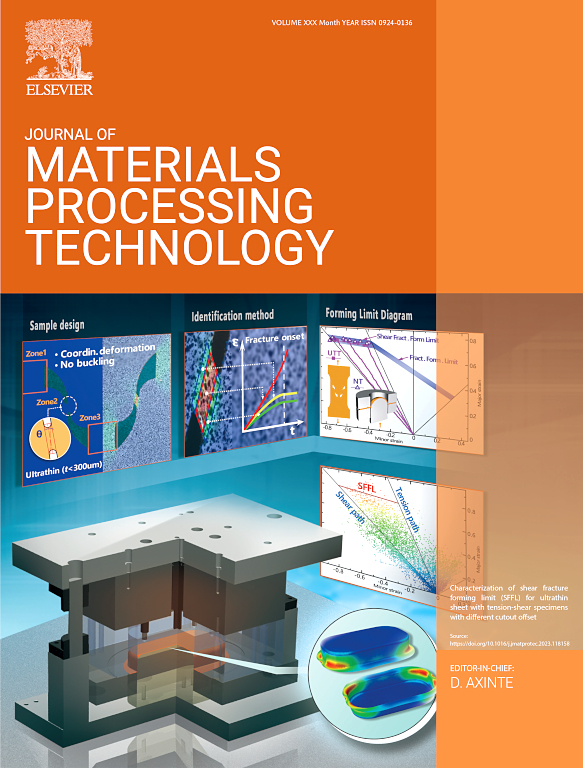Mechanical property enhancement of Inconel 625 through pulse modulations in LDED and further improvement via increased γ’’ precipitation through tailored heat treatment
IF 6.7
2区 材料科学
Q1 ENGINEERING, INDUSTRIAL
Journal of Materials Processing Technology
Pub Date : 2025-06-29
DOI:10.1016/j.jmatprotec.2025.118952
引用次数: 0
Abstract
This work dealt with pulsed wave laser additive manufacturing of Inconel 625 (IN625) using a laser directed energy deposition (LDED) route, envisioning refined microstructure evolution with superior mechanical characteristics and greater chemical homogeneity. A comparative analysis between microstructural and mechanical characteristic evolution under continuous wave (CW) and pulsed wave (PW) mode with varying duty cycle and frequency was analysed. In-process infrared pyrometer captured the temperature dynamics of the molten pool revealing greater insights into the periodic thermal fluctuations under four different PW modes. The study showed microstructural refinement with visible restriction in columnar grain growth and a transition towards higher equiaxed grain evolution under PW mode at lower duty cycle and frequency. Moreover, the extent of elemental segregation was also limited through PW laser irradiations leading towards greater chemical homogeneity. PW modes resulted in the evolution of a weak mixed texture comprising of copper, brass and R/S components. PW laser irradiation under low duty cycle and frequency thus led to the evolution of IN625 parts with near isotropic microstructural properties. Greater high angle grain boundary evolution and significant presence of low angle grain boundaries enhanced the mechanical characteristics of sample fabricated under PW mode especially under 50 Hz frequency compared to CW mode as evident from microhardness and tensile analysis. Further improvement in mechanical properties was obtained through direct double aging heat treatment (DA1 and DA2) attributed to greater γ’’ and δ phase precipitation proximity to grain boundaries, the presence of which was confirmed through scanning electron microscopic and transmission electron microscopic analysis. An improvement of 10–12 % in tensile stress was registered for DA1 and DA2 samples compared to corresponding non-heat-treated ones.
通过led脉冲调制提高Inconel 625的机械性能,并通过定制热处理增加γ”析出进一步改善
本研究采用激光定向能沉积(LDED)工艺对Inconel 625 (IN625)进行了脉冲波激光增材制造,实现了具有优越机械特性和更高化学均匀性的精细微观结构演变。对不同占空比和频率的连续波(CW)和脉冲波(PW)模式下的组织和力学特性演变进行了对比分析。过程红外高温计捕获了熔池的温度动态,揭示了四种不同PW模式下的周期性热波动。研究表明,在较低占空比和频率的PW模式下,晶粒细化,柱状晶粒生长受到明显限制,晶粒向高等轴晶演化过渡。此外,PW激光辐照也限制了元素偏析的程度,从而导致更大的化学均匀性。PW模式导致了由铜、黄铜和R/S组分组成的弱混合织构的演变。低占空比和低频率的PW激光辐照使IN625零件具有接近各向同性的显微组织性能。显微硬度和拉伸分析表明,与连续波模式相比,PW模式下制备的样品的高角度晶界演化和明显的低角度晶界存在增强了力学特性,特别是在50 Hz频率下。直接双时效热处理(DA1和DA2)进一步改善了合金的力学性能,这是由于在晶界附近有更多的γ”和δ相析出,通过扫描电镜和透射电镜分析证实了这一点。与未经热处理的样品相比,DA1和DA2样品的拉伸应力提高了10-12 %。
本文章由计算机程序翻译,如有差异,请以英文原文为准。
求助全文
约1分钟内获得全文
求助全文
来源期刊

Journal of Materials Processing Technology
工程技术-材料科学:综合
CiteScore
12.60
自引率
4.80%
发文量
403
审稿时长
29 days
期刊介绍:
The Journal of Materials Processing Technology covers the processing techniques used in manufacturing components from metals and other materials. The journal aims to publish full research papers of original, significant and rigorous work and so to contribute to increased production efficiency and improved component performance.
Areas of interest to the journal include:
• Casting, forming and machining
• Additive processing and joining technologies
• The evolution of material properties under the specific conditions met in manufacturing processes
• Surface engineering when it relates specifically to a manufacturing process
• Design and behavior of equipment and tools.
 求助内容:
求助内容: 应助结果提醒方式:
应助结果提醒方式:


